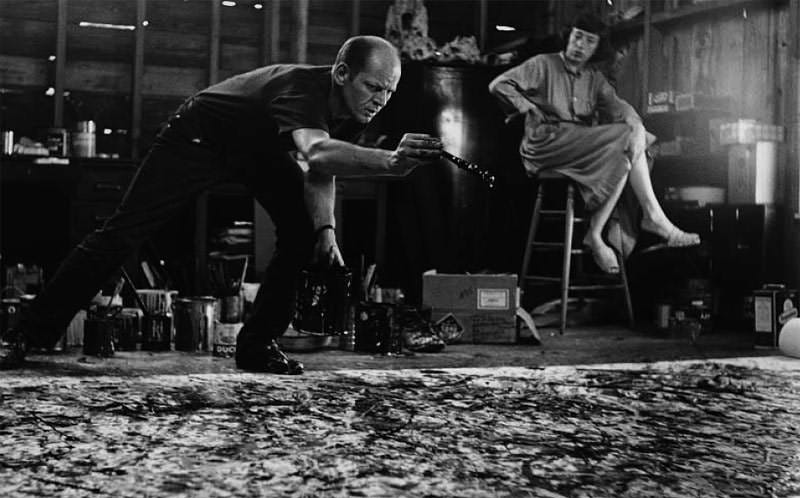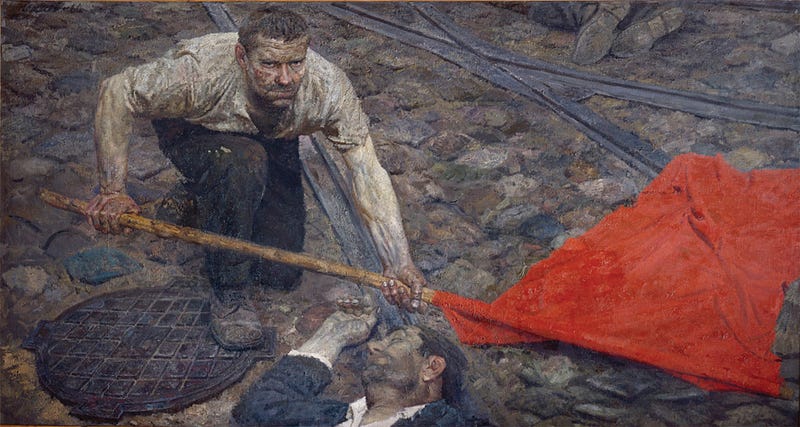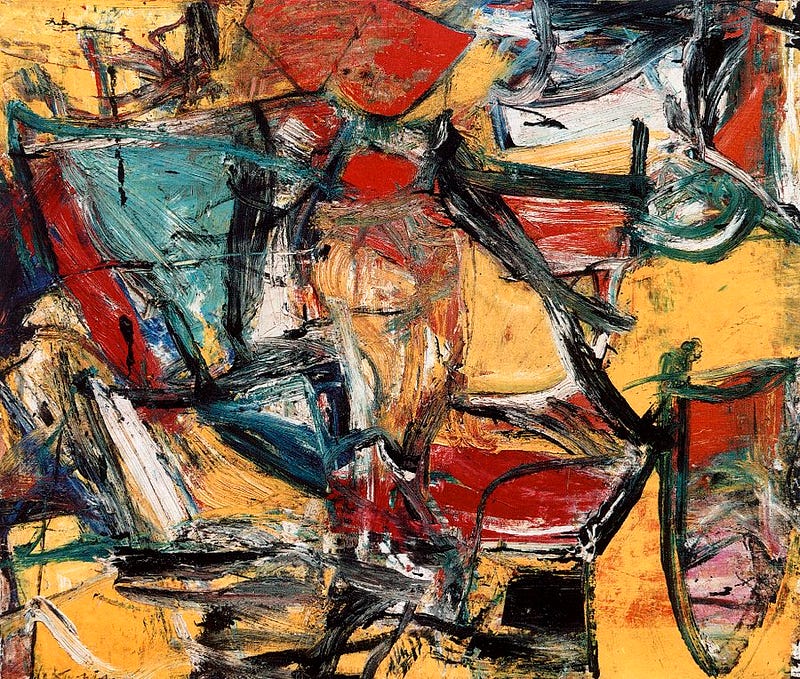How Jackson Pollock and the CIA Teamed Up to Win The Cold War
Unlikely bedfellows, ironic subterfuge, and the American Left
"I could do that."
We've all thought it, whether out loud or in secret, standing in the hallowed halls of museums of modern art across the world witnessing the violent glorified entropy of abstract expressionism.
An art form defined by lack of form, it has become an easy target for both scorn and idolatry. It is the butt of so many jokes, and yet produced three of the ten most expensive paintings in history.
What began as a rejection of ideology has become an ideology all unto itself; modern art requires a certain faith. There are those who "get it" and those who just simply don't.
So, at the advent of abstract expressionism, why did the CIA want people to "get it" so badly?
That may seem like an odd question.
In the early 1950's, folks had much greater criticism for abstract expressionism than the fact that it looked easy to make. Remember, this is the time of grey suits, white picket fences, and McCarthyism. Harold Harby, Los Angeles councilman, declared:
"Modern art is actually a means of espionage. If you know how to read them, modern paintings will disclose weak spots in U.S. fortifications, and such crucial constructions as the Boulder Dam."
George Dondero, a Republican from Missouri, made a simpler proclamation, on floor of Congress no less:
"All modern art is Communistic."
This paranoia would rapidly become policy when, in 1947, the State Department withdrew a touring exhibition of modern art that it had sponsored, titled "Advancing American Art".
A congressman made the argument that this exhibit was an attempt to "tell the foreigners that the American people are despondent, broken down, or of hideous shape." The show was cancelled and the State Department issued a directive that it would no longer financially sponsor any art produced by those with leftist connections, even of the second degree.
And the story of the government's connection to the art form could've ended there.
See, nearly all avant-garde artists at the time had flirtations with the left. Jackson Pollock worked in the Communist workshop of Mexican muralist David Alfalo Siquieros. Adolph Gottlieb and William Baziotes were Communist activists.
So one could forgive McCarthyites for seeing only red in the palette of abstract-expressionism. But the CIA saw an altogether more colorful picture.
In the same way the Soviet Union standardized language, education, and industrial production, it similarly standardized art. By Stalin's directive, there was only one aesthetic which was acceptable: socialist realism. During the Soviet Congress of 1934, acceptable art was defined as:
1. Proletarian: art relevant to the workers and understandable to them
2. Typical: scenes of everyday life of the people
3. Realistic: in the representational sense
4. Partisan: supportive of the aims of the State and the Party
The CIA noticed one very crucial fact about abstract expressionism: it was the polar opposite of socialist realism.
Donald Jameson, former CIA agent, said
"We recognized that this was the kind of art that did not have anything to do with socialist realism… Moscow in those days was very vicious in its denunciation of any kind of nonconformity… So one could quite adequately and accurately reason that anything they criticized that much and that heavyhandedly was worth support in one way or another."
More than that, abstract expressionism was fundamentally American. Born in New York City, there was nothing else like it in the world. There was a "cowboy" element to it — Jackson Pollock, for instance, was born on a sheep farm in Cody Wyoming, slinging paint from the hip like a six-shooter. It was loud, brash, unrefined, and unapologetic — much like America.
However, due to the aforementioned ban instituted by the State Department, this abstract-expressionism had to be supported in covert through several degrees of separation. Soon, the CIA found the ideal conduit for resources: the Museum of Modern Art in New York.
Nelson Rockefeller, president of the museum (and son of its founder) had various agency and government connections. He was Coordinator of Inter-American Affairs (CIAA) in WW2, heading the wartime intelligence agency for Latin America. He was a trustee of the Rockefeller Brothers Fund, a New York think tank subcontracted by the government to study foreign affairs (and through which much of the CIA's financial support of the new art would be laundered).
He would go on to be appointed Eisenhower's special advisor on Cold War strategy, chair a committee overseeing CIA covert operations, and eventually become Governer and Vice President.
The Museum's board was a who's who of CIA connections. William Burden chaired the CIA's Farfield Foundation. Rene D'Hanoncourt worked with the CIAA and reported regularly to the State Department. Nearly everyone involved at the museum had government connections, whether in the State Department, Foreign Service, or CIA.
In 1952, the CIA, through the Rockefeller Brothers Fund, gave MoMA a five year grant to fund the "International Program", loaning out so many of the museum's paintings to European entities that New Yorkers began to complain of an emptied museum. By 1956, 33 full international exhibitions had been organized for abstract expressionism; a remarkable feat.
America's new artistic export caught on rapidly, displacing many European styles and succeeding in its mission of evangelization by force, show, and money. One anecdote seems particularly apropos— in 1960, at the exhibition "Antagonismes" in Paris, movers had to saw off the top of the museum entrance door to carry in a large Pollock canvas.
In the same year, John Canaday reflected that "an unknown artist trying to exhibit in New York couldn't find a gallery unless he was painting in a mode derived from [abstract expressionism]." Adam Gopnik would later state that the monolithic artistic dominance of the art form had forced "two generations of realists to live in basements and pass around still-lifes like samizdat."
Fundamentally, the CIA made Jackson Pollock rich. They made De Kooning and Rothko household names. And in doing so, they won the cold war. Not with guns, but with abstract expressionism and rock and roll.
And there's something deliciously ironic about that, isn't there? The CIA fought communism by making a communist painter wealthy (with capitalism). The abstract-expressionist movement, meant to reject ideology and politics, was used as an ideological hammer for political ends.
Today, in a world where the threat of communism no longer looms, cultural warfare seems as absurd as dripping paint on canvas. Just as capitalism is a profound global normalcy, so is abstract art. Hotels, offices, and banks all over the world now hang abstract expressionist pieces for their diverse clientele; perfectly inoffensive, the visual equivalent to elevator music.
So many dollars, minds, and lives went into the proliferation of abstract expressionism. And yet for all this collective effort, there's something profoundly and individualistically American about it.
We are all protagonists here. It's the American dream — when we see an abstract painting, we think the same words as when we see an American entrepreneur, or when a child sees an astronaut.
Something inside us says, "I could do that."
All quotes, unless otherwise noted, from "The Cultural Cold War" by Frances Stonor Saunders. Special thanks to Lucrezia Di Martino, whose thesis led to me discovering this topic.






No comments:
Post a Comment